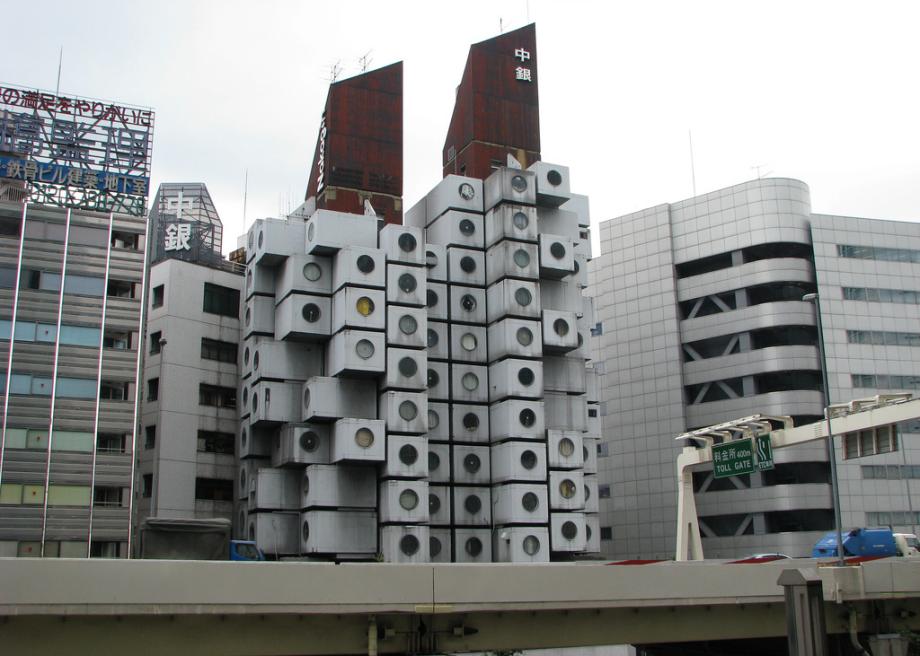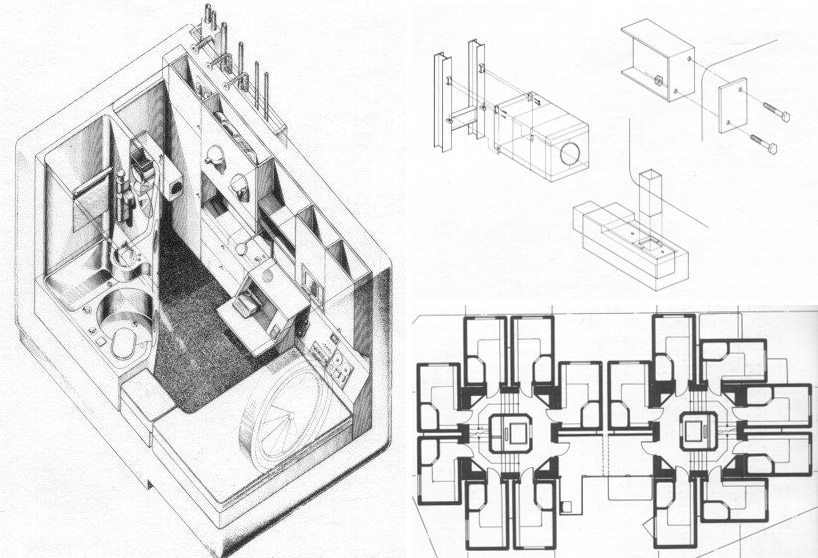Hello Everyone:
Happy start of a new magic sharpie-free week on the blog. Finally the hot weather has subsided, at least for now. The Brexit mess is one giant poo pile. Blogger is saddened by the imminent departure of Speaker of the House of Commons John Bercow. Speaker Bercow announced his intention to resign from Parliament at the close of the current session on October 31st from the floor of the HoC. Yours Truly will genuinely miss the Speaker's no-nonsense handling of the often boisterous sittings. Can Blogger get an ordaaaah in tribute to John Bercow. Onward.
Today, we are going to chat about the Nakagin Capsule Tower in Tokyo, Japan. Yours Truly first became acquainted with it several years and did not have much of an opinion about it. It is not exactly the first thing that comes to mind when discussing Japanese architecture. One usually thinks of graceful feudal period temples and castles. A 13-story tower in the middle of the Ginza district that looks like someone piled washing machines on top of each other? Not so much. Be that as it may, the Nakagin Capsule Tower is a part of Japan's storied architectural history and is currently under threat of demolition. Why save it?
 |
| The Nakagin Capsule Hotel (1972) Kisho Kurokawa Shinbashi, Tokyo, Japan slate.com |
Breaking news: The Guardian is reporting that Liberal Democrats are ready to support revoking article 50, which triggered Brexit (theguardian.com; Sept. 9, 2019). Now back to our regularly scheduled post.
This example of Metabolic architecture is about its big close next summer when the Summer Olympics opens in the thriving business district. Exciting as this prospect sounds, the Capsule Tower's fate hangs in the balance. Marie Doezema reports, "Last year, a limited-liability company bought the land under the tower (which is a condominium) from the original developer and announced its intention to redevelop it, and said it would prohibit future sales of capsules, which it can do under Japanese law" (Ibid). On July 29, Jiji Press reported,
 |
| Close up of individual capsules nationalgeographic.com |
Currently, a foreign company is holding negotiations on acquiring the building in the upmarket Ginza district...
Nakagin Integration Inc. last year sold the title to the land used for the building to a real estate company,... (nippon.com; July 29, 2019; date accessed Sept. 9, 2019).
This is good news for the Capsule Hotel, which was doomed for demolition a year ago. Now a foreign company is negotiating to acquire the land rights and hopefully save the tower.
The Capsule Tower is one of the outstanding surviving examples of Metabolism "a postwar architectural movement in Japan. Metabolism was largely theoretical movement that viewed buildings not as static but as regenerative, and its architects planned megastructures composed of both permanent and impermanent parts, so they could evolve over time" (citylab.com; Aug. 26, 2019). The Metabolist manifesto, Proposal for a New Urbanism (1960), described it,
We regard human society as a vital process, a continuous development from atom to nebula. The reason why we use the biological word metabolism is that we believe design and technology should denote human vitality (Ibid).
 |
| Nakagin Capsule Hotel plan, detail, an isometric drawing Kisho Kurakawa designboom.com |
The Nakagin Capsule Tower was commissioned by Torizo Watanabe, the president of the Nakagin real estate firm. "He was impressed by Kurokawa's designs at the 1970 World Expo in Osaka and wanted to see a major work by him realized in Tokyo" (Ibid). Each of the towers were put together from 140 prefabricated steel units; connected to each of the building's twin concrete cores with high-tension bolts (Ibid). Kisho Kurokawa intended that each of the 100 square foot capsules be replaced as needed, allowing for "a perpetual renewal of the building" (Ibid). However forty years later, none of the capsules have been replaced and the building is inching toward decrepitude. Many of the capsules are maintained by others are in a state of decay.
 |
| Capsule interior nationalgeographic.com |
In the intervening years, enthusiasm for the Capsule Tower has waned in concert with its state of repair. The Nakagin real estate firm told The Japan Times in 2014,
Right now, there are no ways to preserve the building at a reasonable maintenance cost, but the property cannot be destroyed without approval from at least four-fifths of [unit] owners (Ibid).
In 2007, the former management team approved plans for demolition, citing deterioration and asbestos. The Tokyo real estate brokerage Japan Property announced,
The construction company chosen to lead the redevelopment filed for bankruptcy shortly afterwards and the redevelopment plan was put on hold. By 2010 the discussion was raised again but a growing divide between owners in favor of demolition and those in those in favor of preserving the exiting structure led a standstill (Ibid)
 |
| Tatsuyuki Maeda splinternews.com |
Tatsuyuki Maeda, a member of the Nakagin Capsule Tower Building Conservation and Regeneration Project, hoped the Capsule Hotel will not be demolished because of place in the architectural history continuum and its popularity with tourists. In an email to CityLab, Mr. Maeda wrote,
The capsule was originally intended to be replaced in 20 to 25 years, but 47 years have passed without a replacement. There are many problems that cannot be solved without replacing the capsules, such as waterproofing of the capsule's outer wall, asbestos removal, maintenance of the water supply pipe, the construction of new air conditioners, and seismic reinforcement. (Ibid)
Breaking news: British Parliament voted against snap elections, handing Prime Minister Boris Johnson another defeat (nytimes.com; Sept. 9, 2019)
Tatsuyuki Maeda owns 15 capsules in the Tower and hopes to tilt the balance towards preservation. As of a couple of weeks ago, the Tower's chances of survival were about 50 percent.
Architecture critic Julian Rose wrote in his essay for photographer Noritaka Minami's book 1972 (amazon.com; date accessed Sept. 9, 2019), he firmly believed in preservation; he would like to
[see] the tower as a nostalgic glimpse into a world of unrealized possibilities,...."while proponents of demolition" see a manifestly failed proposal for a now obsolete model of urban living, a relice whose time has come" (citylab.com; Aug. 26, 2019). One thing everyone seems to agree on is that the Nakagin Capsule Tower is an irreplaceable gem--for better or worse.
No comments:
Post a Comment